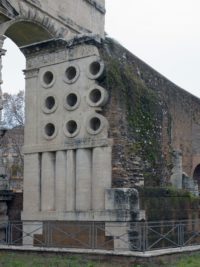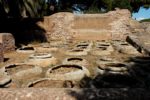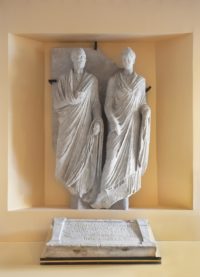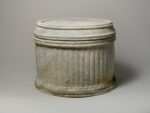 Between 50 and 20 B.C., in the late Republic, early Imperial period, a man named Eurysaces built a tomb outside the eastern boundary of Rome. Part of what is today called the Porta Maggiore after the nearby Church of Santa Maria Maggiore. Two inscriptions identify the tomb’s owner. The complete one says: EST HOC MONIMENTUM MARGEI VERGILEI EURSYACIS PISTORIS REDEMPTORIS APPARET, meaning “This is the monument of Marcus Vergilius Eurysaces, baker contractor, public servant. His name, the Latin nomen and Greek cognomen, could be indications that he was a freedman, a manumitted slave who became a wealthy and successful baker. His name is not followed by L or LIB for libertinus to denote freedman status, however. It wasn’t a requirement that freedmen identify themselves this way, but it was a widespread practice. He could also have just been a poor immigrant who made good and wanted to broadcast as much in his own stab at immortality with a tomb dedicated to his success in business.
Between 50 and 20 B.C., in the late Republic, early Imperial period, a man named Eurysaces built a tomb outside the eastern boundary of Rome. Part of what is today called the Porta Maggiore after the nearby Church of Santa Maria Maggiore. Two inscriptions identify the tomb’s owner. The complete one says: EST HOC MONIMENTUM MARGEI VERGILEI EURSYACIS PISTORIS REDEMPTORIS APPARET, meaning “This is the monument of Marcus Vergilius Eurysaces, baker contractor, public servant. His name, the Latin nomen and Greek cognomen, could be indications that he was a freedman, a manumitted slave who became a wealthy and successful baker. His name is not followed by L or LIB for libertinus to denote freedman status, however. It wasn’t a requirement that freedmen identify themselves this way, but it was a widespread practice. He could also have just been a poor immigrant who made good and wanted to broadcast as much in his own stab at immortality with a tomb dedicated to his success in business.
 The three surviving facades of the tomb feature a unique design: three rows in five columns of hollow circles in the third story. It is sui generis as tomb design, but could represent dolia frumentaria, massive round-mouth earthenware jars that had capacities in the hundreds of gallons and were used to store grain for commercial enterprises. (Dolia were used to store pretty much every foodstuff, liquid and solid — wine, oil, fresh and dried fruits and vegetables, salted ham, fish, fish guts in the fermentation of garum. They’ve been found on shipwrecks and buried in rows up to their shoulders in industrial and commercial neighborhoods.)
The three surviving facades of the tomb feature a unique design: three rows in five columns of hollow circles in the third story. It is sui generis as tomb design, but could represent dolia frumentaria, massive round-mouth earthenware jars that had capacities in the hundreds of gallons and were used to store grain for commercial enterprises. (Dolia were used to store pretty much every foodstuff, liquid and solid — wine, oil, fresh and dried fruits and vegetables, salted ham, fish, fish guts in the fermentation of garum. They’ve been found on shipwrecks and buried in rows up to their shoulders in industrial and commercial neighborhoods.)
A far more literal representation of the baker’s craft is sculpted in a frieze below the cornice. Every stage of commercial bread-making is depicted, from the milling of grain on the south façade to the baking of the loaves on the north façade to the weighing and sale of the bread on the west.
The tomb survived construction of the Aqua Claudia in the middle of the 1st century. The soaring arches of the aqueduct loomed over and all around it, but it remained intact. The construction of the Aurelian Walls in the 3rd century took a march larger toll, absorbing the tomb into the new defensive perimeter. The east façade was destroyed when the tomb was built into a tower of the Porta Praenestina. Finally the tomb was fully enclosed in reinforcements of the wall built by the emperor Honorius.
In 1838, the structures built by Honorius were demolished by order of Pope Gregory XVI who had a notion that stripping later modifications would return the gate to Cladius’ original. During the works, the baker’s tomb was rediscovered. The Pope let it stand despite his pet project and today it remains in place at the Porta Maggiore.
 There was more to it than the parts of the structure that are still standing. Crews discovered fragments of inscriptions and sculptural elements that had fallen off the tomb or been knocked down. The most significant was a full-length marble relief portrait of an adult man and woman. Expertly carved wearing the highly draped traditional Roman garb of tunic and toga (for him) and tunic and palla (for her), the figures look dignified and expensive, not unlike the family portraits of Augustus and Livia on the Ara Pacis. The woman is even wearing her hair like Livia’s.
There was more to it than the parts of the structure that are still standing. Crews discovered fragments of inscriptions and sculptural elements that had fallen off the tomb or been knocked down. The most significant was a full-length marble relief portrait of an adult man and woman. Expertly carved wearing the highly draped traditional Roman garb of tunic and toga (for him) and tunic and palla (for her), the figures look dignified and expensive, not unlike the family portraits of Augustus and Livia on the Ara Pacis. The woman is even wearing her hair like Livia’s.
An epitaph found in the rubble appears to match this relief. It reads: FUIT ATISTIA UXOR MIHEI FEMINA OPITUMA VEIXSIT QUOIUS CORPORIS RELIQUAE QUOD SUPERANT SUNT IN HOC PANARIO, meaning “Atistia was my wife; a most excellent lady in life; the surviving remains of her body are in this breadbasket.” A cinerary urn in the shape of a cylindrical basket was found near the tomb during the 1838 demolition. It is now lost and we have only drawings of it to go by, but this  shape and type of urn was common at that time,
shape and type of urn was common at that time,
(see this early Imperial urn in the Metropolitan Museum of Art for a very similar example), so it’s possible Atistia’s remains were kept in a breadbasket-like urn and placed in the tomb.
It’s likely that the relief and inscription adorned the lost eastern façade of the tomb. Eurysaces, described in such detail on the surviving facades, is the man in the relief and the speaker in the inscription. He created the epitaph and relief to give his wife a tiny sliver of the credit he gives himself on the rest of the building.
The relief portrait has long been out of public view, but after an extensive restoration project that included creating a plaster replacement head for Atistia whose original head was stolen in 1934, it is back on display at the Sala Colonna of the Centrale Montemartini museum. For the occasion, the marble epitaph has been loaned by the Museo Nazionale Romano, and a miniature plaster replica of the tomb as it was when it was intact on loan from the Museo della Civiltà Romana.
On a peronal note, I missed all four of the eastern gates of the Aurelian Wall during my epic wall walks in Rome last October. Next time I’m going full Wrath of Khan on them. They task me. They task me and I shall have them.
Myself, I had the immediate impression of a baking oven, but I reckon that only ‘steamers’ might actually feature those type of holes. Thus, the holes might indeed represent ‘dolia frumentaria’ or ‘pithoi’.
Much in contrast to Marcus’ own minger (Did he survive the arena?), his uxor Atistia looks –even after 2000 years of wear off– still ‘most excellent’. Moreover, I wonder, where the chiseller might have originated from, and if he spoke some dialect, as some words do look -to an unskilled eye like mine- rather weird, ..e.g. ‘OPITUMA’, ‘VEIXSIT’. Marcus spelled with ‘G’, additional ‘E’s and ‘I’s etc. (‘quoius’ looks alright, though).
Remarkably, ‘Eursyacis’ might have to do with σῦαξ (or flatfish), or it is a place that I never heard of. Moreover, εὔρις = ‘with a good nose’ vs. sacer = dedicated — Surely, Marcus had a flattened nose for farina. Presumably, they were all from a Greek Southern Italy.
…When it comes to baking ovens, check out this and maybe also that one.
:hattip:
Wait a minute… I dare say, for redemption …on the photo, it more clearly says…
Est hoc monimentum marci vergili eurysac[IS PISTORIS REDEMPTORIS APPARET…],
i.e. there are no ‘E’s, where they don’t belong.
Also it puts εὔρις = ‘with a good nose’ and sacer = dedicated back onto the table. The “L” or “LIB” might be coded in the ‘REDEMPTORIS’. redemptio = buying back, releasing, ransoming, redemption, but indeed also undertaking by contract (etc.).
What wont release properly, it seems, is Liv’s KEYBOARD 😉